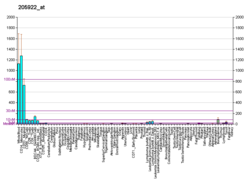Protein-coding gene in the species Homo sapiens
| VNN2 |
|---|
|
| Identifiers |
|---|
| Aliases | VNN2, FOAP-4, GPI-80, vanin 2 |
|---|
| External IDs | OMIM: 603571; HomoloGene: 130041; GeneCards: VNN2; OMA:VNN2 - orthologs |
|---|
| Gene location (Human) |
|---|
 | | Chr. | Chromosome 6 (human)[1] |
|---|
| | Band | 6q23.2 | Start | 132,743,870 bp[1] |
|---|
| End | 132,763,459 bp[1] |
|---|
|
| RNA expression pattern |
|---|
| Bgee | | Human | Mouse (ortholog) |
|---|
| Top expressed in | - blood
- monocyte
- granulocyte
- palpebral conjunctiva
- periodontal fiber
- trabecular bone
- right lung
- spleen
- bone marrow
- gallbladder
|
| | | More reference expression data |
|
|---|
| BioGPS |  | | More reference expression data |
|
|---|
|
| Gene ontology |
|---|
| Molecular function | - hydrolase activity, acting on carbon-nitrogen (but not peptide) bonds, in linear amides
- hydrolase activity
- pantetheine hydrolase activity
| | Cellular component | - anchored component of membrane
- membrane
- extracellular region
- plasma membrane
| | Biological process | - nitrogen compound metabolic process
- pantothenate metabolic process
| | Sources:Amigo / QuickGO |
|
| Orthologs |
|---|
| Species | Human | Mouse |
|---|
| Entrez | | |
|---|
| Ensembl | | |
|---|
| UniProt | | |
|---|
| RefSeq (mRNA) | |
|---|
NM_001242350
NM_004665
NM_078488 |
| |
|---|
| RefSeq (protein) | |
|---|
NP_001229279
NP_004656
NP_511043 |
| |
|---|
| Location (UCSC) | Chr 6: 132.74 – 132.76 Mb | n/a |
|---|
| PubMed search | [2] | n/a |
|---|
|
| Wikidata |
|
Vascular non-inflammatory molecule 2 is a protein that in humans is encoded by the VNN2 gene.[3][4][5]
This gene product is a member of the Vanin family of proteins which share extensive sequence similarity with each other, and also with biotinidase. The family includes secreted and membrane-associated proteins, a few of which have been reported to participate in hematopoietic cell trafficking. No biotinidase activity has been demonstrated for any of the vanin proteins, however, they possess pantetheinase activity, which may play a role in oxidative-stress response.
The encoded protein is a GPI-anchored cell surface molecule that plays a role in transendothelial migration of neutrophils. This gene lies in close proximity to, and in same transcriptional orientation as two other vanin genes on chromosome 6q23-q24. Two transcript variants encoding different isoforms have been described for this gene.[5]
References
- ^ a b c GRCh38: Ensembl release 89: ENSG00000112303 – Ensembl, May 2017
- ^ "Human PubMed Reference:". National Center for Biotechnology Information, U.S. National Library of Medicine.
- ^ Galland F, Malergue F, Bazin H, Mattei MG, Aurrand-Lions M, Theillet C, Naquet P (Dec 1998). "Two human genes related to murine vanin-1 are located on the long arm of human chromosome 6". Genomics. 53 (2): 203–13. doi:10.1006/geno.1998.5481. PMID 9790769.
- ^ Martin F, Malergue F, Pitari G, Philippe JM, Philips S, Chabret C, Granjeaud S, Mattei MG, Mungall AJ, Naquet P, Galland F (Aug 2001). "Vanin genes are clustered (human 6q22-24 and mouse 10A2B1) and encode isoforms of pantetheinase ectoenzymes". Immunogenetics. 53 (4): 296–306. doi:10.1007/s002510100327. PMID 11491533. S2CID 10763223.
- ^ a b "Entrez Gene: VNN2 vanin 2".
Further reading
- Suzuki K, Watanabe T, Sakurai S, et al. (1999). "A novel glycosylphosphatidyl inositol-anchored protein on human leukocytes: a possible role for regulation of neutrophil adherence and migration". J. Immunol. 162 (7): 4277–84. doi:10.4049/jimmunol.162.7.4277. PMID 10201959.
- Dahlgren C, Karlsson A, Sendo F (2001). "Neutrophil secretory vesicles are the intracellular reservoir for GPI-80, a protein with adhesion-regulating potential". J. Leukoc. Biol. 69 (1): 57–62. doi:10.1189/jlb.69.1.57. PMID 11200068. S2CID 18220316.
- Watanabe T, Sendo F (2002). "Physical association of beta 2 integrin with GPI-80, a novel glycosylphosphatidylinositol-anchored protein with potential for regulating adhesion and migration". Biochem. Biophys. Res. Commun. 294 (3): 692–4. doi:10.1016/S0006-291X(02)00538-7. PMID 12056825.
- Strausberg RL, Feingold EA, Grouse LH, et al. (2003). "Generation and initial analysis of more than 15,000 full-length human and mouse cDNA sequences". Proc. Natl. Acad. Sci. U.S.A. 99 (26): 16899–903. Bibcode:2002PNAS...9916899M. doi:10.1073/pnas.242603899. PMC 139241. PMID 12477932.
- Takeda Y, Fu J, Suzuki K, et al. (2003). "Expression of GPI-80, a beta2-integrin-associated glycosylphosphatidylinositol-anchored protein, requires neutrophil differentiation with dimethyl sulfoxide in HL-60 cells". Exp. Cell Res. 286 (2): 199–208. doi:10.1016/S0014-4827(03)00071-5. PMID 12749849.
- Sendo D, Takeda Y, Ishikawa H, et al. (2004). "Localization of GPI-80, a beta2-integrin-associated glycosylphosphatidyl-inositol anchored protein, on strongly CD14-positive human monocytes". Immunobiology. 207 (3): 217–21. doi:10.1078/0171-2985-00235. PMID 12777063.
- Sasaki H, Ide N, Sendo F, et al. (2004). "Glycosylphosphatidyl inositol-anchored protein (GPI-80) gene expression is correlated with human thymoma stage". Cancer Sci. 94 (9): 809–13. doi:10.1111/j.1349-7006.2003.tb01523.x. PMC 11160170. PMID 12967480. S2CID 20499237.
- Mungall AJ, Palmer SA, Sims SK, et al. (2003). "The DNA sequence and analysis of human chromosome 6". Nature. 425 (6960): 805–11. Bibcode:2003Natur.425..805M. doi:10.1038/nature02055. PMID 14574404.
- Yoshitake H, Takeda Y, Nitto T, et al. (2004). "GPI-80, a beta2 integrin associated glycosylphosphatidylinositol-anchored protein, concentrates on pseudopodia without association with beta2 integrin during neutrophil migration". Immunobiology. 208 (4): 391–9. doi:10.1078/0171-2985-00281. PMID 14748512.
- Gerhard DS, Wagner L, Feingold EA, et al. (2004). "The Status, Quality, and Expansion of the NIH Full-Length cDNA Project: The Mammalian Gene Collection (MGC)". Genome Res. 14 (10B): 2121–7. doi:10.1101/gr.2596504. PMC 528928. PMID 15489334.
- Liu T, Qian WJ, Gritsenko MA, et al. (2006). "Human Plasma N-Glycoproteome Analysis by Immunoaffinity Subtraction, Hydrazide Chemistry, and Mass Spectrometry". J. Proteome Res. 4 (6): 2070–80. doi:10.1021/pr0502065. PMC 1850943. PMID 16335952.
- Nitto T, Takeda Y, Yoshitake H, et al. (2007). "Structural divergence of GPI-80 in activated human neutrophils". Biochem. Biophys. Res. Commun. 359 (2): 227–33. doi:10.1016/j.bbrc.2007.05.087. PMID 17543284.














